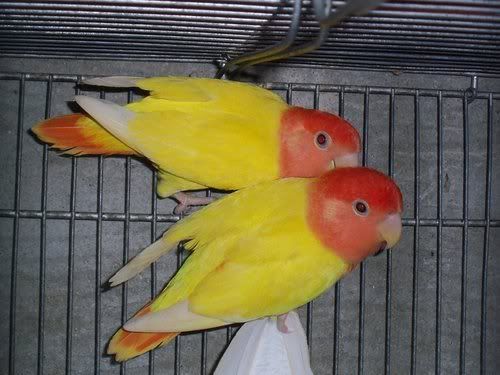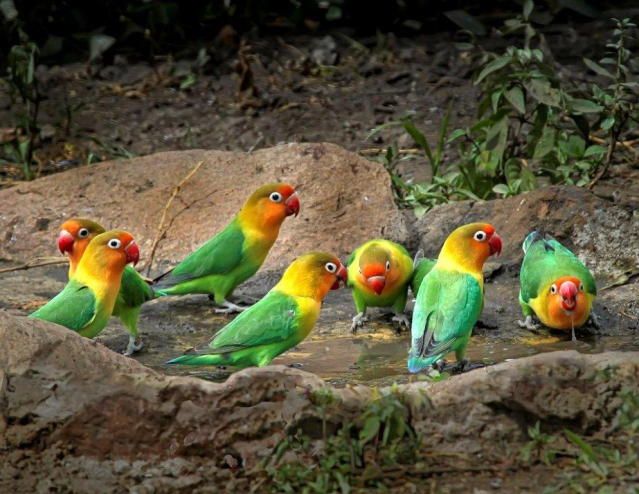WELCOME TO THE WORLD OF AFRICAN LOVEBIRDS!!!
AFRICAN LOVEBIRDS GROUP (AGAPORNIS)
BLACK MASKED GROUP ( AGAPORNIS PERSONATA)
BLACK CHEEKED GROUP
BACK2BACK LUTINO OPALINE PAIR
AFRICAN LOVEBIRDS IN THE WILD
Before you start
Buying mostly goes as follows: after visiting either an exhibition or a breeder they have become acquainted with, the person decides to keep birds. Somewhere or other this person has an empty shed or space for an aviary. After a couple of days of activity when the shed or aviary is ready for occupation the person takes a trip to a dealer and in no time at all becomes the proud owner of some pairs. The problems mostly start here: the birds are too old or not racially pure, the accommodation turns out to be too small, eggs are laid but the hatchlings die, and so on. Things would have possibly worked out better if some thought and preparation had been applied in advance.
As a beginner it all depends on what you want, a tame parrot as a living room pet that won’t simply scream the house down? In this case it’s best to choose a young bird that’s been hand reared because it will get used to you quicker. Lovebirds are colony birds and they don’t like living completely alone. Birds that are deprived of the company of their own sort can over time develop psychogenic disorders. These are physical sickness symptoms caused by psychological problems and you can best avoid them by buying at least one cock and hen pair.
Not all breeders sell their better birds, so when you’re buying you must ensure that the birds are well feathered. There should be no bare patches anywhere on the body. As long as you keep the new birds separated from others, infectious illnesses shouldn’t arise.
If you want to use the birds to start breeding, the first step is to decide what you want or better said what you are capable of handling. Birds need daily care and attention, so if you’re not going to have any time for them it’s best not to start at all. I work with twenty or so breeding pairs, for example, which demands a little less than an hour of my time per day.
Should you decide to go ahead and breed lovebirds, find out as much as you can for yourself in advance. Visit some exhibitions and get to know a breeder. There are also specialised lovebird societies and associations you can join.
What to look out for?
Once you know what you want to do with the birds you’re planning to buy, it’s time to decide which birds you want to buy. You can use the following guidelines:
* If you’re looking for a tame household pet the best choice is A. roseicollis.
* Check that the bird you fancy is healthy. The easiest way is to look to make sure that the bird isn’t sitting shaped like a ball with its feathers puffed up. You can also use you fingers to feel along the muscles either side of the breastbone. These should be firm enough for the breastbone not to feel sharp to the touch. The bird should not be too thin.
* If you are looking for breeding birds, A. roseicollis, A. fischeri or A. personatus are the most suitable to begin with because they breed quite easily. In the early stages, restrict yourself to the natural colour and give yourself time to learn about inheritance. If you were to start to experiment immediately, you would almost certainly end up disappointed so it’s best to leave more complex crossings to more experienced breeders for the time being.
* Don’t take on too many birds. It’s quality that counts, not the quantity, and you will be better off to pay a little more for a good couple than to buy two cheaper, lower quality pairs.
* Buy only young, ringed birds.
* It’s sometimes difficult to be sure of a birds *** so get the breeder to agree during purchase to exchange a bird in the event you should discover that the couple is not a pair.
* Find out when the birds were hatched and from which parents they came.
* Find out what food the young birds have been given until now. This information is very important if you are buying a young breeding bird. Some breeders put young birds into separate cages and give them the minimum of diets simply because they are going to be sold. If feed lacks the necessary vitamins and minerals, this can lead to disappointing breeding results in the first year. I personally buy birds that are about six months old to give myself six months to feed them a balanced diet in preparation for breeding
Where to buy?
Although many breeders rear their birds well it’s important for beginners to know that some don’t.
* Don’t buy your birds just anywhere. Visit as many breeders as you can in your area so that you can quickly separate the wheat from the chaff and pay special attention to the following points:
* Accommodation and hygiene must of the highest standard. If feed and drink dishes are seriously contaminated (with droppings or green algae) and the birds are getting little or no fresh air, it’s highly likely that they will not be in their best condition.
* Inspect the bird’s accommodation paying special attention to the droppings. Even though lovebirds, like all other birds, excrete faeces and urine from the same body opening (the cloaca), the droppings should not appear to be too watery. Droppings that are too watery may indicate digestion problems that result in the urine component being produced but no faeces.
* It goes almost without saying that to avoid inbreeding you should not buy a pair that are related to each other. Every respectable breeder keeps a breeding register detailing which animals are related to each other.
* When you are buying an animal to introduce new blood into your aviary choose a specimen that is preferably three and half years old or more. This will reduce the risk of the newcomer passing a virus infection on to your other birds (this principally concerns ‘Psittacine Beak and Feather Disease’).
* Don’t accept a bird that for any reason doesn’t appeal to you. Don’t feel obliged to buy. If you feel uncertain, take somebody with you who has a little experience in bird breeding. No respectable fancier will object.
Lovebirds are pint-sized bundles of joy. They have the full personality of parrots while being easy to house because of their size. Lovebirds are little clowns, playing for hours at a time. They love to hang from toys, spin them around, and dance on your shoulder. Watch out for your buttons! They love to pull them off your shirts! They love to snuggle and preen. Many people believe lovebirds must be kept in pairs. This is simply not true. A single lovebird makes a better pet because it bonds to you rather than to another lovebird. While it is easy to keep a pair of lovebirds tame, if you plan on spending lots of time with your bird you can keep it alone. However, if you work long hours and don't think you'll have a lot of time for your love bird, we recommend you get him a companion. This will keep your lovebirds happy and prevent boredom.
It is important to realize that while lovebirds are a small parrot, they have the intelligence and abilities of some of the largest parrots. They can amaze you with their ability to escape their own cages (I have to put clips on the cage doors to keep them in, and sometimes they figure out how to open those!), they will sometimes try to become the little bosses of the household (hence, the same type of gentle dominance training used for larger parrots should be used with lovebirds), and they can learn to mimic sounds and speech on occasion (N.B. We don't recommend you buy any species of bird only because of the expectation that it will speak; even the famous African Greys sometimes don't learn to speak, and if that is a person's only reason for buying a bird, the bird could end up abandoned because of the owner's disappointment. In our opinion, parrots make great pets e
The name "lovebird" refers to the nine species of the genus "Agapornis". Eight of these species originate on the African continent, with the ninth coming from the island of Madagascar.
Three species of Lovebird, the Peachfaced, Masked, and Fischer's, are relatively common in captivity. The remaining species are either uncommon, or completely unknown in aviculture, and are collectively referred to as "the rares."
The Common Species
Peachfaced Lovebird (Agapornis roseicollis)
Masked Lovebird (Agapornis personata)
Fischer's Lovebird (Agapornis fischeri)
Just Click the link
-: Pin Lovebird is a breeder of good quality of Lovebirds in both White-Eye Ring and Non-Eye Ring. Pinfarm Lovebrid breed 700 pairs of male and female Lovebird :-
Lovebirds, Agapornis, African Parrots, Peachfaced Lovebirds
Agapornis Page hosted by Dirk Van den Abeele
Results 1 to 10 of 3610
Thread: All about african lovebirds!!!
-
05-12-2009, 11:04 PM #1
 All about african lovebirds!!!
All about african lovebirds!!!
-
05-13-2009, 07:39 AM #2
-
05-13-2009, 10:32 AM #3Junior Member

- Join Date
- Jan 2009
- Gender

- Posts
- 174
post naman lagi ka bai, nice kau imong mga matured personata da, pm nya kos mga price ana be, thnks
-
05-13-2009, 07:47 PM #4
-
05-14-2009, 09:31 AM #5
-
05-14-2009, 09:55 AM #6Junior Member

- Join Date
- Nov 2008
- Gender

- Posts
- 104
rear species man ni
-
05-14-2009, 11:16 AM #7
Thanks, maka-picture nko resulta sa naglive-in nko ALBS karon. Diha man gud ko nadakpan Isabel nisuroy sa ako cages, nya ako gibutang sa walay pares "lonely" nakong Fisher, loving na kaayo ron. Ako lang nya ipa-divorce sila kun makapalit ko pair para nilang duha... Maglisod pako palit ug pang-pair kay dko kabisado mo-sexing sa ALBS... pero sure ko nga male & female ni sila, baw-an ra ni kun kinsa molumlum nya...
-
05-14-2009, 12:34 PM #8
Sir ang "buknoy" nga result from breeding a peachface and either a fischer or a personata is not able to breed kai sterile na sila but a hybrid from a non same eyering species pairing like a fischer cock and a personata hen will result in a fertile hybrid and that's how we get the high mutes of masked lovebirds i.e persopied...

-
05-14-2009, 06:42 PM #9
-
05-14-2009, 08:07 PM #10Junior Member

- Join Date
- Dec 2007
- Posts
- 460
up for this thread, nice birds ozracer....
i would like to see a chick from a buknoy pair... if someone could post a pix please. Nindot ciguro na nga breed kay nindot man ang buknoy tan-awon.
Advertisement
Similar Threads |
|











 Reply With Quote
Reply With Quote





